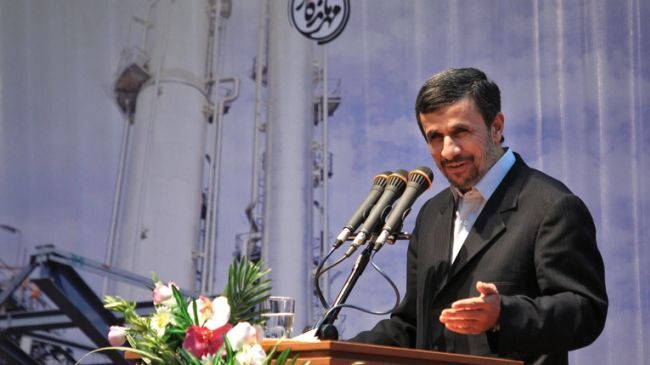Iran opens biggest NGL plant in Persian Gulf

By Sara Rajabova
Iranian President Mahmoud Ahmadinejad has inaugurated the largest associated petroleum gas (APG) plant in the Persian Gulf, built on the southern Iranian island of Siri to produce condensate and gather associated gas.
"Oil and gas are national wealth and we should make the optimum use of this blessing in order to develop the country," Ahmadinejad said at the inauguration ceremony in Siri Island on Thursday.
The Iranian president added that the Siri Island would turn into a center for exporting gas because of its advantageous location.
Praising the progress of the country's oil industry, Ahmadinejad said Iran must reach a point where it can design and implement international projects.
The plant, which went on stream on Thursday, will produce natural gas liquids (NGL) and when fully operational, would on average collect 100 to 104 million cubic feet per day (mcfpd) of dry gas, thus preventing associated petroleum gas from being flared.
The NGL plant will also produce 1,500 barrels per day (bpd) of pentane, 4,000 bpd of butane, 1,400 bpd of gas condensate, and 8,000 bpd of propane.
Besides, Iranian Oil Minister Rostam Qasemi said Iran is implementing all of its oil and gas projects despite the restrictions imposed on the country.
Addressing the opening ceremony, Qasemi said the development and completion of oil and gas field projects were the top priority of Iran's oil industry.
Qasemi also said Iran planned to build NGL plants in the southern coastal provinces to prevent "40 million cubic meters of gas mixed with oil" from going to waste.
Qasemi said in spite of sanctions imposed by 27 member countries of the European Union, some Asian and European states have expressed readiness to purchase condensate and natural gas liquids produced in Siri.
The U.S. government imposed new sanctions on Iran's energy sector, targeting Iranian oil revenues. The sanctions, which took effect on February 6, prevent Iran from gaining access to earnings garnered from its crude exports.
In November 2012, the U.S. Senate approved sanctions against Iran's energy, port, shipping, and shipbuilding sectors, in a bid to mount economic pressure on Iran.
Last October, the European Union announced a package of sanctions against Iran, which focuses on Iranian banks, trade, and gas exports.
Moreover, over $18 billion has been invested in Iran's upstream oil sector since the beginning of the current Iranian calendar year (March 20, 2012), National Iranian Oil Company official Abdolmohammad Delparish was quoted as saying.
He added that 70-75 percent of the investments have been made in joint oil and gas fields.
Earlier in February, National Iranian Oil Company managing director Ahmad Qalebani said Iran's oil revenues during the past Iranian calendar year amounted to $110 billion.
The figure was a record high in the history of Iran's oil industry, he added.
Last year, $22.6 billion was invested in the upstream sector of the oil industry, compared to $16.7 billion two years ago, he noted.
Qalebani also said that the total volume of capital invested in the exploitation of Iranian gas field South Pars will reach $17 billion in the current Iranian calendar year.
The South Pars gas field is divided between Iran and Qatar. The field contains about 14 trillion cubic meters of gas, or about eight percent of world reserves.
Iran gives priority to enhancing the capacity of gas production at its joint oil fields with Qatar and Saudi Arabia.
Currently Iran produces 300 million cubic meters of gas at the South Pars field.
Here we are to serve you with news right now. It does not cost much, but worth your attention.
Choose to support open, independent, quality journalism and subscribe on a monthly basis.
By subscribing to our online newspaper, you can have full digital access to all news, analysis, and much more.
You can also follow AzerNEWS on Twitter @AzerNewsAz or Facebook @AzerNewsNewspaper
Thank you!
